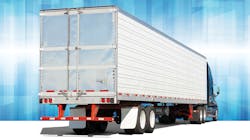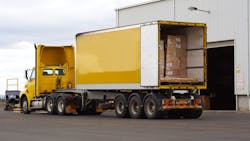Accurate visibility. Fleets of all kinds, especially less-than-truckload operators, require accurate eyes on trucks but—most especially—trailers.
They do count on technology but also on their old-fashioned “analog” experience and knowledge to keep trailer utilization rates higher. This is key in a time when e-commerce is making the supply chain more complicated (and, as the world has seen this year, out of sync) and when dwell times for U.S. drivers are higher—a top-ranked problem, as the industry research group American Transportation Research Institute (ATRI) has found out. In ATRI’s most recent survey, dwell times rank as the No. 2 concern behind only the driver shortage, according to commercial drivers themselves.
It could be said then that trailer tracking is several parts science but other parts smarts. And if the delicate dance is done well, a carrier’s trailer operations can run smoothly and utilization can remain high.
See also: How to maintain long-lasting tractor-trailer connections
“If the wheels don’t turn, you don’t earn.” That’s an axiom that is as true with trailers as it is with tractors.
It’s common for trailers, especially within LTL operations, to sit idle at least 20% to 30% of the time because of a variety of factors, according to industry estimates. Downtime for a single tractor costs an estimated $400 to $700 a day in lost productivity, as reported by trucking experts. For trailers, estimates vary, but there are many more of them attached to any given fleet compared to tractors. And trailers face their own maintenance challenges, while the focus for any fleet is its powered units. And just as the maintainer shortage is coming into focus for tractors, so it is for trailers.
Every minute a trailer is parked in a yard or a maintenance shop, the return on investment in that trailer is reduced, just like it is for tractors. And carriers desperately try to avoid idle time—as well as driver dwell time at terminals when drivers wait for that trailer to be loaded or unloaded.
In April, DataPulse, a quarterly fleet utilization survey from MacKay & Co., a research firm that specializes in the aftermarket truck parts market, showed that in the first quarter of 2022, total power Classes 6-8 utilization was 86.2% compared to an initial fleet forecast of 82%, John Blodgett, VP of sales and marketing at MacKay & Co., said during a Heavy Duty Manufacturers Association Pulse webinar. But indicative of strong freight movement, trailer utilization also hit new highs, with full-service lease and rental fleets nearing 97% utilization rates and for-hire carriers up over 93%. So the focus is on utilization across all fleet operations of any size.
COO sees large playing field
Frank Granieri has a view from 30,000 feet of trailer utilization every day. As chief operating officer of A. Duie Pyle, Granieri oversees a predominantly less-than-truckload operation but one that also has dedicated, brokerage, and warehouse and distribution businesses and quite extensive infrastructure.
He oversees the trucking end of Pyle’s operations but also the terminal and warehouse end of them. West Chester, Pennsylvania-based Pyle runs 27 LTL service centers in 13 states in the eastern U.S. It also has four regional truckload and warehouse locations in Pennsylvania and 11 warehouse operations in a total of five states.
According to its website, Pyle, which is ranked No. 76 on the FleetOwner 500: Top For-Hire Fleets of 2022 list, has 1,975 professional drivers and a fleet of 1,611 power units but also an inventory of 2,687 trailers. Big fleet, lots of trailers, lots of logistics needed to keep track of them all. Pyle also has a trailer leasing arm. It’s not uncommon for large fleets to have more trailers compared to their number of tractors, Granieri said, as a rundown of the FleetOwner 500 demonstrates.
“In the end, the customer receiving the trailers of goods must efficiently run their operation. It’s a constant push-pull between shipper-carrier and receiving. No matter the technology, the process, or automation that comes into the industry, these nuances will always be present. In the end, all three pieces have to work together for each to succeed and be sustainable.”
LTLs like Pyle have particular challenges with trailer tracking and utilization, Granieri noted, since by definition they allow multiple shippers to share space on the same tractor-trailer. This is done with technology, yes, but also with the help of fleet managers and terminal operators and their meticulous maintenance of traditional manifests and their regular yard checks, he said.
“Everyone sees how much waste there is in our industry because of dwell times. Utility of these assets are still based on a very static time frame,” he added. “If you think about an LTL, drivers depart our terminals, and everything that moves is on a manifest that is indexed to a tractor and a trailer. We have a step built in that we verify that we have the accurate trailer, in the [pickup-and-delivery] cycle of the move. There’s always that chain of custody, from a manifest perspective, trailer number used for tracking system.”
The Pyle COO mentioned current challenges in maintaining high trailer utilization—and he emphasized “current” because many are related to the especially challenged supply chain of recent weeks and months. His top two challenges are labor shortages and discipline in allocating the available trailer population.
“Ensuring we’re prepared for supply chain constraints and labor constraints from the fleet maintenance perspective,” he said, mentioning the shortage of trained personnel qualified to maintain trailers as well as heavy tractors, but also the shortage of trailer loaders and unloaders at terminals and the general shortage of personnel and warehouse facilities nationwide.
“We have to have discipline in ensuring allocation of the trailer population. Because labor is constrained, there is this delay in unloading trailers [and] a delay in normal equipment available at certain sites. Where we saw that more was in the early part of this year, when the labor market was in really bad shape, and especially in our dedicated part of the business. [Trailers] weren’t getting turned quickly at distribution centers.”
See also: Execs struggle to gauge capacity trends ahead of peak season
With the supply chain as tangled as it has been, the trucking industry debates the merits of “drop and hook”—where the driver “drops” a full container or trailer at a facility and “hooks” their tractor to a preloaded trailer at the same facility. In trucking, this stands in contrast to a “live load”—when a driver arrives at a facility, docks with a trailer, and waits for terminal or warehouse personnel to load or unload the cargo.
As the driver waits during this time, detention fees can accrue and increase the overall costs for the load. Meanwhile, the driver is detained, burns hours-of-service time, and loses income from his or her primary job, which is to haul freight.
Pyle COO Granieri had definite opinions about drop and hook and its role in trailer utilization. “Drop-and-hook business is a blessing and a curse,” he said. “It’s a blessing because delay times at warehouses continue to get worse and worse. A driver wants to drive, not sit and wait.”
“The downside of this scenario is the equipment needs of the carrier and occasional lack of urgency from warehouse teams knowing they have the flexibility of the drop to be unloaded. These deliveries can occasionally be put on the back burner. Ultimately, the carrier and equipment involved is at the mercy of the warehouse that might have their own labor/efficiency challenges.”
This is Part 1 of a feature that appeared in the August edition of FleetOwner magazine. Part 2 also appeared on FleetOwner.com.
About the Author
Scott Achelpohl
Managing Editor
Scott Achelpohl is a former FleetOwner managing editor who wrote for the publication from 2021 to 2023. Since 2023, he has served as managing editor of Endeavor Business Media's Smart Industry, a FleetOwner affiliate.



